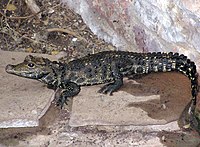Description
Crocodiles are the most advanced of all reptiles despite their prehistoric look. Unlike other reptiles they have a four-chambered heart, diaphragm and cerebral cortex. Their external morphology on the other hand is a sign of their aquatic and predatory lifestyle. A crocodile’s physical traits allow it to be a successful predator. They have a streamlined body that enables them to swim faster. They also tuck their feet to their sides while swimming, which makes the animal even faster, by decreasing the water resistance. They have webbed feet which, although not used to propel the animal through the water, allow it to make fast turns and sudden moves in the water or initiate swimming. Webbed feet are an advantage in shallower water where the animals sometimes move around by walking.
Crocodiles are very fast over short distances, even out of water. They have extremely powerful jaws capable of biting down with 3,000 pounds of pressure per square inch, and sharp teeth for tearing flesh, but cannot open their mouth if it is held closed. There are stories of people escaping from the long-snouted Nile Crocodile by holding its jaws shut. Zoologists will often subdue crocodiles for study or transport by taping their jaws or holding their jaws shut with large rubber bands cut from automobile inner tubes. All large crocodiles also have sharp and powerful claws. They have limited lateral movement in their neck, so on land protection can be found by getting even a small tree between the crocodile's jaws and oneself.
Age
There is no reliable way of measuring crocodile age, although several techniques could be used to derive a reasonable guess. The most common method is to measure lamellar growth rings in bones and teeth - each ring corresponds to a change in growth rate which typically occurs once a year between dry and wet seasons.[1] Bearing these inaccuracies in mind, the oldest crocodilians appear to be the largest species. C. porosus is estimated to live around 70 years on average, and there is limited evidence that some individuals may exceed 100 years. One of the oldest crocodiles recorded died in a zoo in Russia apparently aged 115 years old.[2]
A male freshwater crocodile at the Australia Zoo is estimated to be 130 years old. He was rescued from the wild by Bob Irwin and Steve Irwin after being shot twice by hunters. As a result of the shootings, this crocodile (known affectionately as "Mr. Freshy") has lost his right eye.[3]
Size
Size greatly varies between species, from the dwarf crocodile to the enormous saltwater crocodile. Large species can reach over 5 or 6 meters long and weigh well over 1200 kg (2,640 lb.). Despite their large adult size, crocodiles start their life at around 20 cm long. The largest species of crocodile is the Saltwater Crocodile, found in northern Australia and throughout South-east Asia. According to some scientists,[attribution needed] there are no truly reliable records of any non-prehistoric crocodiles over 8.64 m.
In the town of Normanton, Queensland, Australia, there is an 8.63 meter fibreglass mould of a crocodile called "Krys the Croc.," shot in 1958 by Krystina Pawloski, who found the animal on a sandbank on the Norman River.[4]
The other two larger certifiable records of complete crocodile are both of 6.2 m crocodiles. The first crocodile was shot in the Mary River in the Northern Territory of Australia in 1974 by poachers and measured by wildlife rangers. The second crocodile was killed in 1983 in the Fly River, Papua New Guinea. In this latter crocodile it was actually the skin that was measured by zoologist Jerome Montague, and as skins are known to underestimate the size of the actual animal, it is possible this crocodile was at least another 10 cm longer.
The largest crocodile ever held in captivity is an Estuarine/Siamese hybrid named Yai (Thai: ใหญ่, meaning big) (born 10 June, 1972) at the famous Samutprakarn Crocodile Farm and Zoo, Thailand. This animal measured 6 m in length and weighs 1,114.27 kg (2,450 lb.).
Another huge captive crocodile was a saltie named Gomek. Gomek was captured by George Craig in Papua New Guinea and sold to St. Augustine Alligator Farm in Florida. Gomek died of heart disease in February 1997. By this stage, he was a very old crocodile. When he died, he was 5.5 m long - as confirmed by St. Augustine Alligator Farm - and probably between 70 and 80 years old.
On June 16, 2006, a 7.1 m giant saltwater crocodile in Orissa, India was crowned the world's largest living crocodile. It lives in Bhitarkanika Wildlife Sanctuary and in June 2006, was entered in the Guinness Book of World Records.[5]
Wildlife experts, however, argue that the largest crocodile so far found in the Bhitarkanika was almost 7.62 m which could be traced from the skull preserved by the Kanika Royal Family. The crocodile, probably was shot dead near Dhamara during 1926 and later its skull was preserved by the then Kanika King. The crocodile experts said the crocodile would be about 7.62 m since the size of the skull was measured one seventh of the total length of the body.





No comments:
Post a Comment